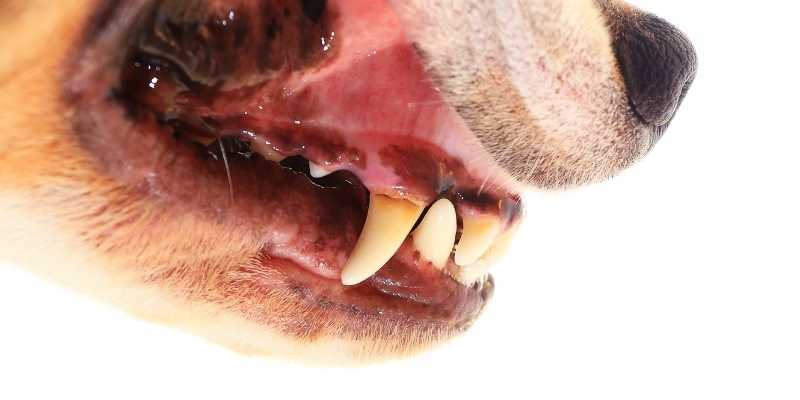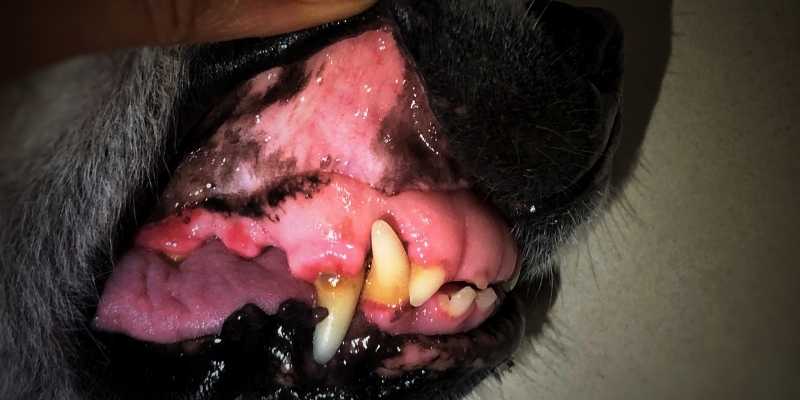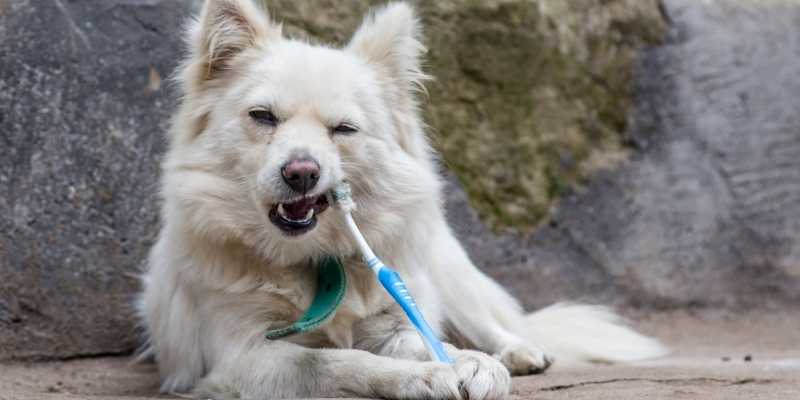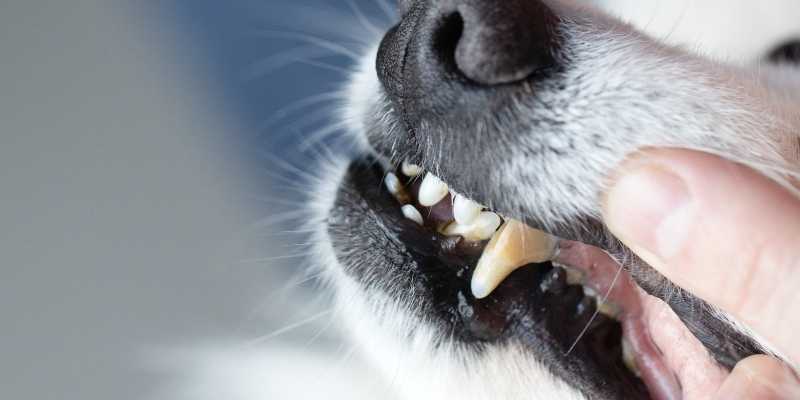You may already be aware that failing to care for your dog’s teeth can result in periodontal disease that causes bleeding gums and even tooth loss.
But poor oral hygiene is also related to different health problems in dogs, such as diabetes and heart disease. Can it even result in a fractured jaw? And because dogs are great at masking pain, you might not even notice there’s a problem. So you better watch out for common signs of bad dog teeth to make sure the treatment is coming on time, and you can avoid all the possible severe dog health consequences.
Do you have a specific question about bad dog teeth signs? Then use the table of contents below to jump to the most relevant section. And you can always go back by clicking on the black arrow in the right bottom corner of the page. Also, please note that some of the links in this article may be affiliate links. For more details, check the Disclosure section at the bottom of the page.
Here's what we'll cover:
Dog tooth brown spot
Suppose your dog has a brown spot on a dog tooth. In that case, an issue is likely developing in your dog’s mouth, such as a canine cavity, stain, or considerable tartar buildup. Unfortunately, dogs cannot communicate and do not convey toothaches or oral discomfort properly. Thus, dog owners must check their dogs’ mouths for infections or cavities frequently. Many vets do an oral exam on a dog’s mouth and uncover cavities if dog owners do not regularly brush their pets’ teeth and give their dogs sugary foods (fruits, honey, etc. ). Very few dog owners notice the mouth cavity before it becomes a problem.
Dogs’ teeth usually acquire a little black or brown patch immediately below the gum line. You will also notice a little hole where the tooth enamel has decayed. The black spot is frequently located within the deteriorated tooth enamel hole.
Dog teeth black at the gum line

Stains or bacteria are the most common causes of black lines on a dog’s teeth.
Stains, despite their unappealing appearance, are easily removed and should not cause any problems in the future.
In the alternative situation, many dogs may develop a black line on their teeth due to an overgrowth of bacteria in the dog’s mouth caused by poor dental care. In other words, tooth decay can cause blackening of the teeth.
Food debris is left on the surface of the teeth when they are not thoroughly cleaned. The bacteria in the mouth will then be able to thrive and spread, generating acid to break down the silt.
The emitted acid might potentially cause enamel damage (the outer layer of teeth).
Depending on where the bacteria is, it might create cavities or gingivitis, developing to periodontal disease. Some pets can have both experiences at the same time.
Tooth and gum decay can lead to tooth loss over time.
Finally, a black line could be caused by black-colored microorganisms on the surface of the teeth and behind the gum line.
Dog has black gums and bad breath
Although you will need to take the dog to a veterinarian for thorough diagnostic tests, you should know what to expect. While it may seem obvious, it is also critical to determine whether or not the gums have turned black. It’s possible that the dog ate something that temporarily discolored their gums a different color, such as biting on a pen and letting the ink flow.
Because the black coloring of your dog’s gums could be caused by an underlying pathology, we must take them to a veterinarian for diagnostics. We mustn’t attempt to medicate the dog ourselves. You may utterly misdiagnose the dog and fail to treat the underlying issue.
Dog teeth cavity
Canine caries occur when bacteria remain in the mouth and secrete acids that break down food particles and the outer layers of teeth.
In this case, the black lines are generated by pigmented bacteria and tartar deposits caused by mineralized plaque.

The dark spots often begin in a tiny area of the bone but can spread and infect the entire tooth.
With improper dental hygiene, the cavity will eventually cut its way into the inner layers of the teeth, causing harm to the roots. As a result, the teeth will lose their strength and may fall out.
The more bacteria that attack the teeth, the more difficult it is to treat the issue. To avoid the formation of cavities, it is always best to maintain good oral hygiene.
Cavities can also cause substantial pain and make chewing difficult. To relieve the irritation and agony produced by the ailment, your dog may smack their lips in the middle of the night.
What if a dog has back teeth?
If you don’t peek inside your dog’s mouth, you might not realize that she has a dental problem, so start there and take a good look. Because your dog can’t tell you if she’s in discomfort, check whether she has poor breath, inflamed and red gums, and yellowish or dark plaque on her teeth.
Stinky breath is a sign of growing dental troubles, as smelling indicates that your pet’s teeth are beginning to accumulate brown or black tartar. If this sticky goo is not removed, it can harden along the gum line, causing pain, bacterial infection, and tooth loss.
Dog teeth plaque buildup

Here’s a simple explanation of how plaque accumulates on your dog’s teeth and why it’s a bigger issue than you might believe.
When your dog eats, sticky plaque builds on his teeth. As the plaque reacts with the salts naturally found in your dog’s saliva, it hardens into tartar.
Tartar causes periodontal disease, a condition in which the gums peel away from the teeth, causing pain, inflammation, infection, and even tooth loss.
Within around 36 hours, plaque can harden into tartar. That is why learning how to eliminate plaque from your dog’s teeth every day is critical to their health and well-being.
Bad dog teeth treatment tips
You should take care of those poor teeth for your dog’s sake. Even if you don’t have the funds to visit a canine dentist, there are some things you can attempt at home.
How to remove plaque from dog teeth?
Brushing a pup’s teeth is one of the simplest and most efficient tasks.
Use pet toothpaste made specifically for dogs. Human toothpaste contains elements that might make your pet sick, and unlike us, they can’t spit it out!
You might want to try pet toothpaste with Aloe vera. It helps fight plaque and heals the gums.
Purchase a pet toothbrush. The bristles are softer and denser than those found on human toothbrushes. You can use a piece of clean gauze or a finger brush on smaller dogs or pups.

How to get rid of tartar on dog teeth?
Have your veterinarian remove the tartar. Your veterinarian will sedate your dog lightly and clean their teeth in the same manner that people’s teeth are cleaned at the dentist. Your veterinarian will be able to remove tartar and buildup below the gum line.
They will also be able to take x-rays of your dog’s teeth to determine if there are any problems with the teeth’s roots. If your dog has any infections or broken teeth, your doctor will be able to remove them to help keep his mouth healthy.
Home remedy for bad dog breath
Coconut oil can aid in the treatment of unpleasant dog breath. It improves digestive, immunological, and metabolic functions, but it also aids in the prevention of bad dog breath. Sprinkle a lovin’ teaspoonful over your dog’s food every day, and you’ll soon be sniffing sweeter breath. Plus, most canines adore its taste. So coconut oil is a pleasant treat for them. Some dog owners even brush their pets’ teeth with coconut oil, making the task one that even the most obstinate canines can’t reject!
Thanks for the blog graphics: Canva.com

Thanks for the blog graphics: Canva.com
Doghint.com is a participant of several affiliate programs. The list includes (but not limited to) the following: VigLink, Refersion, ShareASale, and Amazon Services LLC Associates Program, an affiliate advertising program designed to provide a mean for us to earn fees by linking to Amazon.com and affiliated sites. Doghint.com does not intend to provide veterinary advice. All published articles are meant for informational purposes only and not substitute the professional veterinary consultation.


